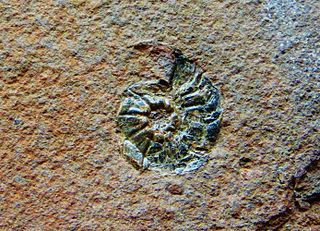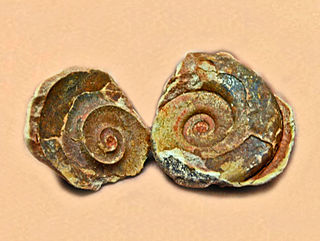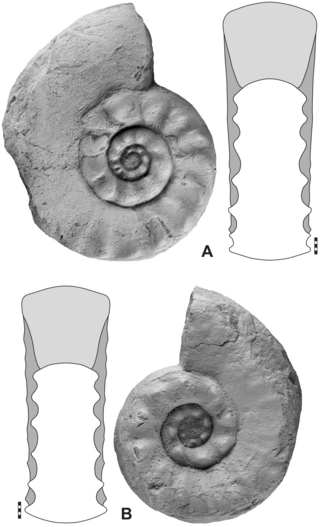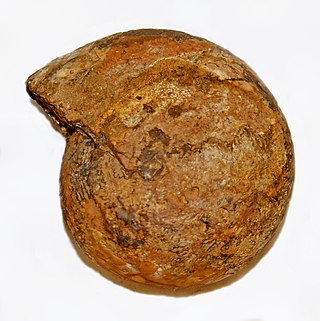Xiphogymnites is an extinct ammonoid cephalopod genus from the Triassic included in the family Gymnitidae. It is known from the Balkans in eastern Europe.

Asklepioceras is a genus in the Ceratitid family Arpaditidae from the Middle and Upper Triassic of Italy, Romania, Turkey, and British Columbia (Canada).
Anderssonoceras is a genus of small, smooth ammonites with a flared umbilical shoulder, like Prototoceras, assigned to the ceratitid family Anderssonoceratidae as the type, but once included in the Otoceratidae.
Arctogymnites is a genus of ammonoid cephalopods from the middle Triassic included in the ceratitid subfamily Beyrichitinae. Related genera include Beyrichites, Frechites, Gymnotoceras, and Salterites
Arctohungarites is a genus of Triassic ammonoids now placed in the ceratitid family Danubitidae, but previously included in the Hungeritidae.
Badiotites is a genus of extinct ammonoid cephalopods belonging to the ceratitid family Badiotitidae. It was previously included with Lecanites in the Lecanitidae, a family formerly of the Clydonitaceae but reassigned by Tozer (1981) to the Danubitaceae. The Badiotitidae is included in the Ceratitaceae.
Dobrogeites is a genus of ammonoids from the order Ceratitida, included in the family Megaphyllitidae that produced evolute compressed planispiral shells with rounded venters, inner whorls ornamented as in Tirolites, outer whorls smooth, suture with multiple smooth lobes; Initially found in Anisian sediments in Romania.

Xenodiscoidea, formerly Xenodiscaceae, is a superfamily within the ammonoid order Ceratitida. The superfamily was named by Frech in 1902, presently contains ten families, only one of which was included in the original Otocerataceae of Hyatt, 1900, the remaining having been added.

Medlicottiidae is a family of ammonoid cephalopods belonging to the Prolecanitida, known from the Upper Carboniferous (Pennsylvanian) to the Early Triassic.
The Ophiceratidae is a family in the ammonoid order Ceratitida from the Lower Triassic, previously included in the Otocerataceae but now placed in the Noritiaceae as revised.
Clydonitoidea, formerly Clydonitaceae, is a superfamily in the ammonoid cephalopod order Ceratitida characterized by generally costate and tuberculate shells with smooth, grooved, or keeled venters and sutures that are commonly ceratitic or ammonitic but goniatitic in a few offshoots.
Ceratitoidea, formerly Ceratitaceae, is an ammonite superfamily in order Ceratitida characterized in general by highly ornamented or tuberculate shells with ceratitic sutures that may become goniatitic or ammonitic in some offshoots.
Lecanites is a ceratitid genus assigned to the Danubitaceae, with an essentially smooth, evolute, discoidal shell and a goniatitic suture with many elements. It is the type and now only genus of the Lecanitidae.
The Danubitoidea is a large and diverse superfamily in the order Ceratitida of the Ammonoidea that combines five families removed from the Ceratitaceae, Clydonitaceae, and Ptychitaceae.

Paratirolites is a genus of latest Permian and earliest Triassic ceratites from Armenia, Azerbaijan, Afghanistan, China and Iran with distinct ribs, prominent ventro-lateral tubercles, and a broadly arched venter. The suture is ceratitic with a large ventral saddle. Ceratites are ammonoid cephalopods that lived during the Late Permian and Triassic.

Gymnitidae is a family of Lower to Middle Triassic ammonite cephalopods with evolute, discoidal shells.
Aplococeratidae is a family of ceratitids from the Middle Triassic with very simplified sutures and a tendency to lose their ornamentation. Shells are generally evolute, more or less compressed, with rounded venters. Ornamentation if present consists of umbilical ribs that disappear outwardly, toward the venter. The suture is ceratitic or goniatitic.
The Hungaritidae comprises a family of ceratitid ammonites described in the Treatise,(Arkell et al. 1957), as involute compressed, discoidal, with keeled or sharpened venter, smooth to weakly costate. Sutures ceratitid, usually with numerous elements.
Dieneria is a genus of ceratitid ammonoid cephalopods from the Late Triassic of western North America with a smooth discoidal shall of which the venter is truncate and the suture simple. Only the first lateral lobe is slightly serrated, the other lobes entire (smooth)

Halorites is an extinct genus of Triassic ammonoids belonging to the family Haloritidae.
E. T. Tozer. 1981. Triassic Ammonoidea: Classification, evolution and relationship with Permian and Jurassic Forms. The Ammonoidea: The evolution classification, mode of life and geological usefulness of a major fossil group 66-100
E. T. Tozer. 1994. Canadian Triassic Ammonoid Faunas. Geological Survey of Canada Bulletin 467:1-663





